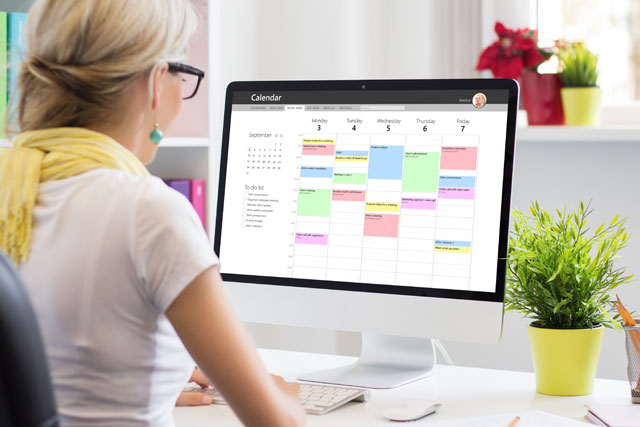When you're just starting out as a professional organizer, things can seem a little overwhelming. Not only are you juggling the responsibilities of your own problems, it's now your job to help your clients juggle their complications. Without a clear system of organizing the different areas of your clients' lives (and your own), you can soon find yourself on the verge of a professional crisis. Fortunately, with a little creativity, instruction, and imagination, you can be well on your way to tackling the obstacles that you encounter in both your personal and professional life.
While there are probably several hundred different techniques that professional organizers rely on to meet their clients' needs, there are a few that are used across the board. Oftentimes you'll even see them combined together, or with other techniques, to morph into supreme organizational genius. As you gain training and confidence in your skills, you'll soon have established your own unique portfolio of creative, one-of-a-kind solutions to your clients' everyday (and not so everyday) predicaments.
In this section, you'll discover four of the most popular professional organizing techniques and systems employed in clients' homes and offices across the globe. The top four tips include color coding, alphabetizing, an "inverse pyramid" approach, and the "one day (or one room) at a time" method. We'll study each of these systems a bit further below.
Ready-Set Solution #1: Color Coding
Perhaps the single most popular approach to organizing just about anything in life involves separating different categories according to a color system. For instance, if you're working with a client with a large family of six, you might devise a color chart like this:
|
Family Member |
Color |
|
Dad |
Red |
|
Mom |
Blue |
|
Sally |
Green |
|
David |
Orange |
|
Caitlyn |
Yellow |
|
Dana |
Purple |
This color-coding system also works in other situations. For example, if you're trying to organize a filing cabinet system for a home office or a company headquarters, you might opt for a system similar to this.
|
Department |
Color |
|
Human Resources |
Red |
|
Marketing |
Blue |
|
Sales |
Green |
|
Administrative |
Orange |
|
President |
Yellow |
|
Vice President |
Purple |
The most important principle to obey when filing things in a color-coded system, is to use that system consistently. If Dad is assigned the color red, that means his towels, robes, suitcases, file folders, wash cloths, etc. should all be purchased in the color red. Just like all of Mom's should be blue, Sally's green and so on. Of course, the same thing would apply in an office setting. If you've given Human Resources the color red, then all papers, folders, files, memos, name tags, etc. should include something red, if nothing more than a simple red circle sticker, to make the designation as easy to understand as humanly possible.
Consistency is so important because it is this, more than anything else, that will determine whether your organizational tips and techniques are truly implemented, or only experimented with. The easier you make it on yourself and your clients to follow through with the system (by constant reminders with colored stickers or other color coded indicators to reinforce the subliminal, second nature aspect of the new habit), the more likely they are to actually integrate your tips and techniques into their daily lives and experience true change and success.
Flexibility is an important aspect of being a successful professional organizer. This means that you must quickly acknowledge that there is no one-size-fits-all answer to disorganization. Color-coding (or any of these four principles) isn't guaranteed to be the most appropriate or effective method for organizing each and every situation. The next method, alphabetizing, is another approach that many organizers have taken to put clutter in its place.
Often when you're working with several papers, files, or different types of media (like CDs, video cassettes, DVDs, back-up discs, etc.) color-coding simply isn't practical. You need another way to organize things without having to use every single color in your kid's giant crayon collection to get it done. When the materials you're working with dictate extensive collections of categories or a great deal of intricate separation, alphabetizing is the way to go.
Even under the simple category heading of "alphabetizing," you're still given several different options to get your materials organized. You can choose to group all of your books in alphabetical order, then all of your CDs in alphabetical order and your DVDs in alphabetical order -- regardless of whether there is any pattern or order to the shape or size of the different articles. Or you might want to first group the articles according to size (for instance, hard back books on one shelf, paper backs on another, larger reference books on another, etc.) and then alphabetize them. Or you may want to categorize them alphabetically according to the author's last name. Or you could even first group them by category (romance novels, sci-fi fantasy novels, how-to manuals, science, history, etc.) and then alphabetize them.
As you can imagine, working with such a broadly reaching method, there's a lot of room for personalization. With a little work, thought and creativity, you should have no trouble devising a system that helps your client gain control over the problematical areas in their personal and professional lives.
The inverse pyramid approach is one frequently referred to in the world of writers and journalists, but applies equally well to the needs of a professional organizer. In a nutshell, the inverse pyramid approach means that you choose to work through a series of small tasks to accomplish smaller, short-term goals that are a part of a focused, larger, long-term goal. But the secret to a truly powerful inverse pyramid attack plan is, well, planning. In essence, your clients will effectively be working at just about every single moment to achieve both their short- and long-term goals using this method. It's consciously involving yourself in what many refer to as a life with purpose.
At its core, the inverse pyramid approach requires a real desire and dedication to setting and achieving goals. In order to get the absolute most out of this approach, you'll have to be willing to ask your clients (or even yourself) some pretty intense questions. Questions like:
- If you could trade places with any other person on the planet, who would you be and why would you want to swap?
- If you were given an unlimited budget and unlimited time in one special destination, where would you go and what would you do when you got there?
- What thing(s) would you most like to change about your family?
- What talent(s) would you like to see yourself develop?
- If you don't change (fill in the blank) about yourself, what's the worst thing that could happen? (Get a little crazy, go to the extreme! Make this list long and powerful -- no less than 10 negative side effects of your behavior.)
- When I do change (fill in the blank) about myself, what are some of the benefits and rewards I can anticipate? (Again, go a little crazy -- really psyche yourself up about it!)
What your answers reveal are not only your dreams, but also goals in disguise, just waiting for someone to act upon them. By planning from the top (the biggest dreams and desires) down (to the little tasks that turn those dreams in reality) and implementing these activities from the bottom up to the top, you'll arm not only your clients, but also yourself, with a system designed to turn even the largest mountain into the most manageable of mole hills.
Try it and see for yourself!
The concept of taking things one at a time isn't just helpful for 12-step addiction programs; it's true about just about every single thing in life. This technique is quite similar to Ready-Set solution #3, with just a few very subtle differences. First of all, taking things one day at a time is an easier way to transition the habitually disorganized into a slow and steady process of becoming organized without overwhelming them.
It's great for individuals who are willing and unembarrassed to admit that they're not ready to start planning things out for the rest of their lives, they just want to be sure that they can make it through the rest of the week.
While this method tends to fail when left only in the hands of the chronically disorganized individual, with the aid of a tried and true professional organizer, there can be some promising results. Why the difference? Because by involving an outside, objective participant, people are better able to slowly work their way up through the ladder of organizational success. There's someone there to encourage them, motivate them, and even reward them when they've stayed on track. And slowly, but surely, as the positive rewards and consequences of leading a more organized life begin to spill over into their everyday lives, the steps and techniques that got them there in the first place will be more strictly adhered to.
Therefore, as their own personal organizational coach, it's your responsibility to stay one step ahead of them. You might start out with a system like this:
|
Day |
Chore |
|
Monday |
Kitchen |
|
Tuesday |
Living Room |
|
Wednesday |
Dining Room |
|
Thursday |
Garage |
|
Friday |
Bedroom(s) |
|
Saturday |
Bathroom(s) |
|
Sunday |
OFF |
Then, once this has become second nature to the client, you might add in something like this.
|
Week |
Chore |
|
Week 1 |
Wash Windows |
|
Week 2 |
Clean Walls/Baseboards |
|
Week 3 |
Clean drapes/curtains |
|
Week 4 |
Polish silver |
|
Week 5 |
Clean the blinds/mini-blinds |
|
Week 6 |
Major outside work needs |
Now, not only are they tackling their daily chores, they've also integrated a major weekly project to accomplish, too. Before you know it, even the most unorganized client you've ever had can begin to break into the habit of habitual organization!
And of course, as we mentioned earlier, none of these solutions is going to work for every single client every single time. But as you foster your portfolio with new clients, tackling new organizational challenges, you'll get a feel for what solutions work and what solutions don't work. But more importantly, you'll be able to distinguish the characteristics and reasons that make one solution work when everything else has failed. Over time, you'll learn what symptoms require what solutions, as well as when it's time to pull a new rabbit out of your hat.
More than likely, as you set out in your career as a professional organizer, the vast majority of your initial clients will be friends, family members, or members of your community that will come to you for help organizing their personal lives. But don't be deceived; this category of "help with their personal lives" can really run the gamut. It can find you doing all sorts of tasks you might not have imagined yourself doing. The people that often want you to help them want you to take them through "crash organizing," but this doesn't work any better than "crash diets." They have to make a plan, and it's your job to help them create a plan they can follow long after you've left (a little like being a life coach in some cases).
But as a general rule, there are a few common areas where you'll regularly find your individual clients looking for help. And using the 10 simple categories we've outlined below, you'll be well on your way to helping them gain control over both their everyday lives and their futures! But remember, knowing all of these principles will do you (and your clients) no good unless you're able to quickly and clearly teach them how to apply these life-changing solutions to their lives.
Don't let them fool you with their talk of spontaneity: People need at least a rudimentary routine. One of the easiest ways for a client to gain control over their life is to gain some control over their schedule. And in order to do that, your client needs to actually have a schedule.
Scheduling and Time Management
Once you've been able to help your client establish some type of routine, it's important to reinforce this routine with some basic principles of scheduling and time management. Perhaps the easiest way to accomplish these tasks is to maintain a master calendar (outlining the major events for the whole family for the next week or month), in addition to a personal agenda.
While a personal agenda will cover a schedule for the next several months, and will include many events that are important to only the owner, there will also be items inside that deserve being moved to the master calendar. For instance, if Martha has a major role in an upcoming play, opening night should be put on the master calendar so the rest of the family can plan on attending.
Motivation is integral to any successful venture, whether the goal is organization or career advancement. Therefore, a fair portion of your task as a professional organizer involves learning how to motivate your clients to get and stay organized.
One of the easiest ways to motivate your clients (and yourself or your family) is by relying on a conscious reminder of the consequences (negatives) and rewards (positives) of specific habits and choices. In order to win the battle over clutter in the "real world," your client has to first win the battle in their mind. Start out by having your client come up with a written list of perhaps 10 or 20 negative scenarios that might result from not changing a specific behavior.Then, have the client assume that they've altered this behavior already and ask them to outline another list with 15 to 20 positive situations they might soon find themselves in because of this change.
When it comes to getting ready, for some people it's a breeze, while to others it's a total nightmare. The chances are that as you set out in your career as a professional organizer, you'll encounter clients who struggle with getting themselves ready to go -- whether they're going to the office, the grocery store, camping, or even to bed.
That's often because so many of these different destinations require their own gear and tools, and trying to find all of them in an unorganized space can be quite the daunting task. If your client is struggling to get ready in a reasonable amount of time, your first step is to help them establish what they think is a reasonable amount of time. Your next step is to ask them what "getting ready" constitutes. Does it include taking a shower? Does it include shaving? Did they remember to add in the time they spend shining their shoes?
Once you've worked with your client to clearly delineate what getting ready constitutes and how long they have to get it accomplished, only then are you able to begin helping them pare down the time they spend getting the job done. This may mean working harder to keep the bathroom and vanity area neat, clean and uncluttered. Or it might mean that they donate a lot of the clothes they don't wear anymore to make it easier to find something they actually want to wear.
Despite the amazing technological advancements we've seen in the past decades, many people are still struggling to get into the habit of returning letters, phone calls, RSVP-ing to special events, and sending thank-you cards to friends and relatives. But this problem is only compounded when the people we should be thanking or replying to take our oversight as a personal offense. It goes without saying that we could save our clients (and ourselves) a great deal of misery and embarrassment if we're able to create a system that makes it nearly impossible to forget to respond.
To begin with, you need to have your client create a single master address book, whether "real" or electronic. Inside, they should input all of the relevant contact information for friends, family members, professional contacts, etc. It's also a good idea to look for a format that allows you to include additional personal information like birth dates, names of spouses and children, etc. This project can be tackled all at once, or in smaller, perhaps 10 to 15 minute increments, as time allows. (If you create an electronic master list, periodically print out a hard copy for easy reference in your "correspondence corner."
Once you're client is fairly organized, prevent papers from piling up again by following this cardinal rule: Only Handle It Once. The goal should be to open something, read it and deal with it immediately. Try not to procrastinate paying the bill or setting a catalog aside to order that sweater later. Chances are, they'll forget about it and the catalog will turn into clutter.
Another major concern of your clients who are in search of personal organization will be spending and budgeting. As you probably gathered from the amount of money poured into advertising credit repair and debt solutions, many families are struggling with their personal finances. And again, one of the largest culprits is plain and simple disorganization.
There are families that meticulously balance the check book after writing every single check but fail to in-put their ATM transactions. Suddenly, they're receiving overdraft notices.
Another family struggles to maintain their rising anxiety as April 15thlooms closer. Frantically they're searching for every last receipt, bank stub, payroll stub, invoice and bill and hurriedly throwing them together into a document box in hopes that their accountant can make sense out of it.
If your client's personal paper management system currently involves several piles of various bills, letters, receipts, invoices, and inquiries (the order of which they are the only ones that understand), then you're more than likely going to have to reform them. But first you've got to convince them there's a better way. And one of the easiest ways to do this is to "show" them, as opposed to 'tell' them, how it works.
Let them have access to an organized, logically arranged filing cabinet and ask them to find a certain file. See how long it takes them to find it. Conversely, take them back to their own "system" and do the same thing. Request that they find a particular file or receipt or invoice and see how long it takes them to get it done. See if they notice the difference.
When it comes to setting up a personal filing system that works, one of the easiest ways to do it is to purchase a filing cabinet or accordion file with space for at least 31 folders or slots -- one for each day of each month. Have them collect their bills, receipts, invoices, deposit slips, letters to answer, etc. each and every day. At the end of each day (at about the same time you should have your clients organizing their schedule for the next day) have them file their receipts in the slot numbered for that day (number 26 for the 26th, etc.), file bills to be paid on the day they should be paid (planning time for them to go through the mail and still not be late) and invoices on the number corresponding to the day they are (a) due and (b) paid in full. Once you've paid a bill, stick the slip of paper and your receipt or check stub back in that day's file. At the end of the month, empty out each of these slots into a large file labeled for that month (for example June 2014), and file it away for tax time.
Streamlining Parenting Skills
This means if you tell Steven every Monday he needs to do the laundry and he doesn't, not only shouldn't he receive his allowance for the week, you should also add an additional consequence to deter him from making the same mistake the next weekend. On the other hand, if Steven's regularly doing his laundry (and even helping do other stuff without being asked) you should not only pay him his allowance, but throw in an additional spiff to let him know he's doing a great job. Whatever you do, don't turn a blind eye and let your kids get away with behavior that isn't acceptable now or later, when they're adults.
There are a lot of parents (and their kids) with schedules so hectic there's barely any time for the essentials -- sleep, relationships, and fun! While we aren't recommending that anyone go out and become a hermit, if anyone is struggling with a planner that's too full, or they feel like there aren't enough hours in the day, you might want to teach them a little bit about priorities.
What good is it if your client's a fantastic ballroom dancer if it means her marriage and house fall apart without her? How much good are all of those football trophies your son might earn if he winds up failing and getting kicked off the team?
The key to helping busy clients manage busy schedules is to help them identify what their real priorities are. Have them list out the 10 most important "things" in their lives. This includes spouses, children, extended family, their career, art, musical abilities, etc. What makes them tick? What would they miss the most if they couldn't have it?
Now have them look at their schedules. Which of those activities fall under the top 10 priorities of their life? Which ones don't? If you and your client have decided that certain tasks need to be eliminated, start with those that fall outside of their priority list.
Career Development Skills
As your clients begin to organize their lives, they soon find themselves with time to devote to their own personal development. Oftentimes, this leads them to consider improving their education or seeking a better position. Another way that professional organizers are able to market their services is by offering to help clients organize their resumes, portfolios, cover letters, job interview skills, wardrobe planning, and other vital career skills. If you've always excelled in these areas, it might be a target market you should pay attention to.
Teach your clients how to transfer the personal organizing techniques you've been giving them, over to their career and professional lives. Give them the skills vital to getting their resume noticed; of wowing a potential employer with a sparkling, crisp, clear cover letter. Enable them to organize a portfolio that gets them a foot in the door and more leeway in salary negotiations.
All the while, you should always take the time to apply the skills you're learning to teach to your clients to your own life and practice. Before you know it, you'll have lots of clients -- and success stories -- to add to that portfolio of yours!































